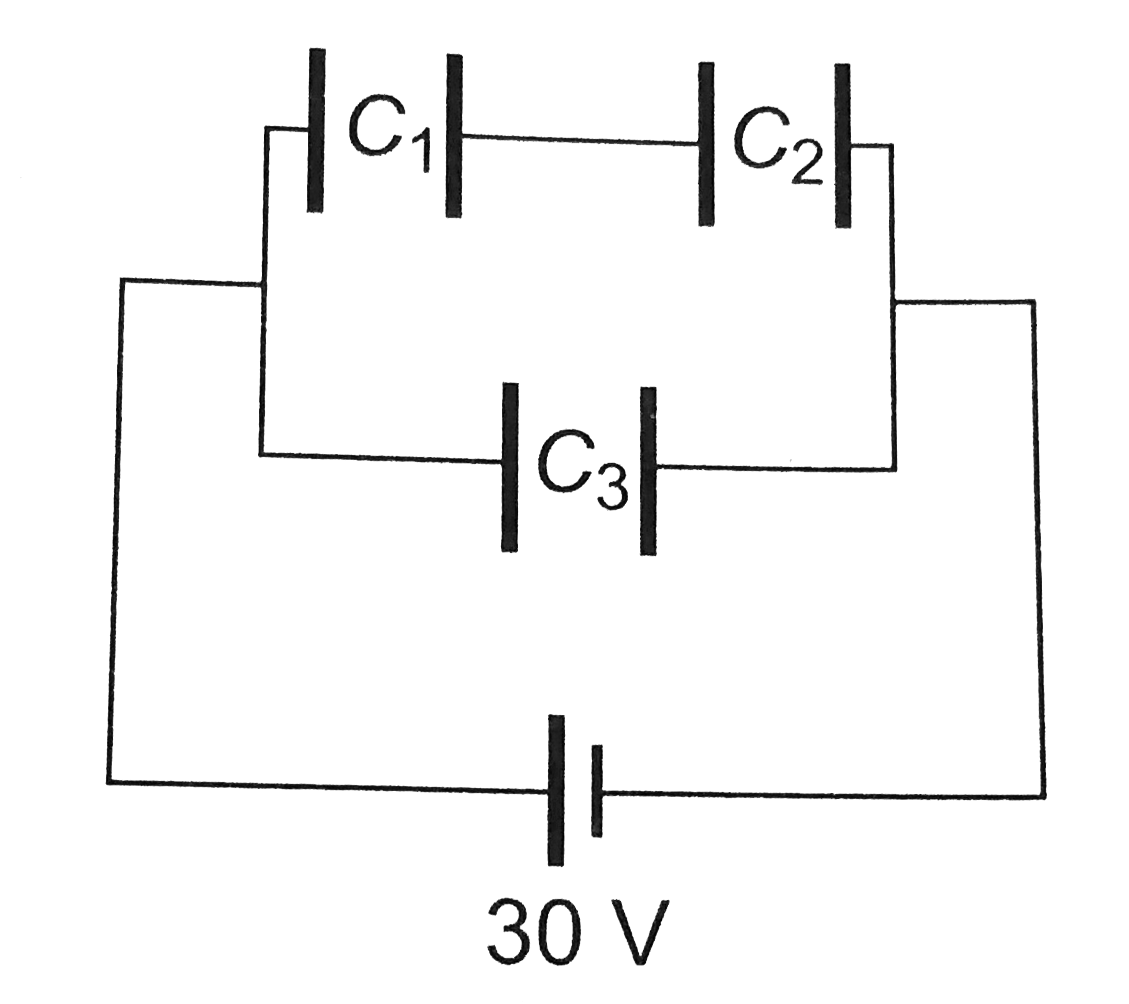A 4μF capacitor is charged to a potential 10V using a battery. The battery is then removed and then this capacitor is connected parallel to an unchanged capacitor of capacity 6μF. What is the common potential?Solution in Tamil
Data supplied, C1=4μF,V0=10V,C2=6μF
Common potential =V
By the law of conservation of charges, C1V0=C1V+C2V=(C1+C2)V
V=C1V0C1+C2=4×10−6×10(4+6)10−6=4V
Topper's Solved these Questions
- BOOK - NEW JOYTHI PUBLICATIONCHAPTER - ELECTROSTATIC POTENTIAL AND CAPACITANCEEXERCISE - Solution To Exercises From Ncert Texation36videos
ELECTROSTATIC POTENTIAL AND CAPACITANCE
- BOOK - NEW JOYTHI PUBLICATIONCHAPTER - ELECTROSTATIC POTENTIAL AND CAPACITANCEEXERCISE - Practice Problems For Self Assessment23videos
ELECTROSTATIC POTENTIAL AND CAPACITANCE
- BOOK - NEW JOYTHI PUBLICATIONCHAPTER - ELECTROMAGNETIC WAVES EXERCISE - COMPETITIVE EXAM CORNER16videos
ELECTROMAGNETIC WAVES
- BOOK - NEW JOYTHI PUBLICATIONCHAPTER - MAGNETISM AND MATTEREXERCISE - COMPETITIVE EXAM CORNER13videos
MAGNETISM AND MATTER
Similar Questions
Two charges 5×10−8Cand−3×10−8C are located 16 cm apart. At what point(s) on the line joining the two charges is the electric potential zero ? Take the potential at the infinity to be zero.
02:56View SolutionCalculating the work done in eV in carrying a charge +e Coulomb through a potential rise of 100 volts. (1.0eV=1.6×10−19joules)
02:29View SolutionIf the total electromagnetic energy falling on a surface is U, then the total momentum delivered (for complete absorption) is
05:19View SolutionChoose the correct statement .
02:32View SolutionA capacitor of capacity C is charged to a potential difference V and another capacitor of capacity 2C is charged to a potential difference 4V . The charged batteries are disconnected and the two capacitors are connected with reverse polarity (i.e. positive plate of first capacitor is connected to negative plate of second capacitor). The heat produced during the redistribution of charge between the capacitors will be
05:57View SolutionA capacitor is charged by a battery. The battery is removed and another identical uncharged capacitor is connected in parallel. The total electrostatic energy of resulting system:
02:50View SolutionIf charge on 5muF capacitor is 50muC , find the potential difference on 4muF and emf of battery.
01:50View SolutionTwo capacitors C1=3μF and C2=6μF in series, are connected in parallel to a third capacitor C3=4μF. This arrangement is then connected to a battery of e.m.f., =30V, as shown. The energy lost by the battery in charging the capacitors
 01:53View Solution
01:53View SolutionTwo capacitors 2μF and 4μF are connected in parallel. A third capacitor of 6μFis connected in series. The combination is then connected across a 12V battery. The voltage across 2μF capacitor is:
02:13View SolutionTwo capacitors of capacitances 4μF and 6μF are connected in series with a battery of 20 V. find the energy supplied by the battery.
03:48View SolutionThree capacitors of capacities 12muF, 6muF and 4muF are connected in series and a potential difference of 20 V is applied to their combination. What is the cahrge on the capacitor of 4muF ?
04:03View SolutionA capacitor of capacitance 4muF is charged to a potential of 100 V. it is then disconnected from the battery and connected in parallel with another capacitor C_(2) . If their common potential is 40 volts, then the value of C_(2) is
04:22View Solutionधारिता 6μF,8μF और 24μF वाले तीन संधारित्र 120 वोल्ट के स्रोत के साथ श्रेणीक्रम में जुड़े हैं। प्रत्येक संधारित्र पर आवेश ज्ञात कीजिए।
03:14View Solutionएक 600 pF धारिता वाले संधारित्र को 200 V की बैटरी से आवेशित किया जाता है। अब संधारित्र से बैटरी को हटाकर संधारित्र को अनावेशित 600 pF धारिता का अन्य संधारित्र से जोड़ा जाता है। इस प्रक्रिया में कितनी स्थिर विधुत स्थितिज ऊर्जा की हानि हुई ?
View SolutionA battery is used to charge a parallel plate combination of two identical capacitors. If the potential difference across the battery is V and the total charge Q flows through the battery during the charging process then 1) The charge on each capacitor is Q/2 and the potential of each capacitor is V/2 2) The charge on each capacitor is Q and the potential of each capacitor is V 3) The charge on each capacitor is Q/2 and the potential of each capacitor is V 4) The charge on each capacitor is Q and the potential of each capacitor is V/2
03:58View Solution

